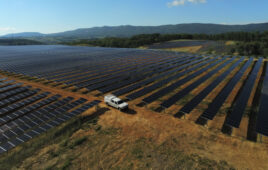Guest post by Jeff Mason, CEO of the Michigan Economic Development Corporation
In the last decade, the solar power industry has grown an average of 68% annually. Nearly 260,000 Americans work in solar at more than 9,000 companies across the country.
One state in particular, Michigan, created more than 5,600 new clean energy jobs in 2016 and is proving to be a contender against traditional energy hubs like New York and California. Ranking third out of 11 Midwest states for clean energy employment, Michigan has more than 92,000 people working in solar and wind combined. And, the state’s clean energy jobs are growing three times the rate of other job sectors.
So, what is driving this solar power growth in a state traditionally known for automobile manufacturing? Much of this growth is in tandem with Michigan’s century-old mobility industry as automakers transition toward clean vehicles that charge via energy subsectors such as solar and wind. The development of Michigan’s solar power industry is also reflective of the state’s larger commitment to renewable energy. For example, in 2016 Michigan signed into law the Clean and Renewable Energy and Energy Waste Reduction Act, which requires electric service providers to supply 15% of their energy from renewable sources by 2021.
Michigan’s Public and Private Institutions Embrace Solar Power
It’s not just statewide legislation that is driving solar power growth across Michigan—local governments have also undertaken numerous efforts toward improving sustainability. Traverse City, located on the northern lakeshore of Michigan’s lower peninsula, recently purchased utility provider Heritage Sustainable Energy’s 1-MW solar array in order to reach its goal of powering the city’s entire government operations with solar energy by 2020.
As for Michigan’s higher education institutions, Michigan State University (MSU) Extension recently developed a program to ensure government officials are prepared to implement renewable energy in their communities. The program trains officials on the context of solar energy development, the types and scales of solar energy and planning approaches and zoning tools. Another group of researchers at MSU has created transparent solar panels that they believe will transform the future of solar applications. Additionally, the university is installing solar carports on its campus. Meanwhile, Western Michigan University constructed a 1-MW solar garden that provides energy for up to 200 homes and is used for education and research.
Some of the most notable solar initiatives in Michigan have been from multinational corporations. General Motors, for example, installed solar grids at its Michigan facilities, and Ford Motor Company implemented a 1-MW solar project at its new headquarters in Dearborn. In addition, atop Swedish retailer IKEA’s 44,000-square-foot store expansion in the Detroit-metro is the largest rooftop solar array in the state. The installation produces 1,408,445 kWh of clean electricity annually—equivalent to reducing 971 tons of carbon dioxide, eliminating the emissions of 204 cars or powering 134 homes.
Beyond these projects, Michigan’s investment in solar has spurred an uptake in energy innovation. Ann Arbor is now No. 1 in clean-tech patent density while Detroit is No. 8 and No. 3 in overall clean-tech patents.
Michigan’s Utilities and Industries Adopt Solar Power
Michigan is home to one of the largest utility-owned solar arrays east of the Mississippi River, the Lapeer Solar Park, newly-opened by DTE Energy. Comprised of 200,000 solar panels across more than 250 acres, the park is producing enough energy to power 11,000 homes. DTE Energy also owns another one of the largest urban solar projects in the Midwest: Detroit’s O’Shea solar park. That 10-acre park was redeveloped as a solar power farm as part of neighborhood revitalization efforts. Another of DTE Energy’s solar initiatives is with Domino’s Farms – a 1.1-MW array near Ann Arbor that is big enough to cover a football field.
Clean energy is penetrating a variety of industries as companies across the board move toward using renewable resources. An already attractive state for aerospace and automotive companies, Michigan supports manufacturing in these industries through access to sustainable solutions. Resources such as the Michigan Emerging Technologies Fund, the SmartZone Network and Pure Michigan Business Connect offer support and market assets needed for entrepreneurs looking to advance clean energy. Overall, Michigan is attractive to solar companies and broader industry due to a competitive tax structure, sound infrastructure and plentiful resources for innovation.
Growth of the solar power industry in Michigan is happening simultaneously with other economic expansion across the state. Case in point, Michigan experienced the most economic improvement of any U.S. state over the past 11 years according to CNBC. Michigan’s competitive ecosystem offers the capacity to support companies looking to lead or invest in solar energy.






Jackson, Mi based Harvest Energy Solutions has been working hard bringing solar to rural and agricultural markets across the Midwest.
And let’s not forget the 13.4 MW dc solar array at Michigan State University. It is the largest solar carport array in the World, covering 5,000 parking spaces on 45 acres.
You should mention one of pioneer solar startups. Greenlancer.com, a Detorit company that brought the soft costs down from thousands of dollars to tens of dollars